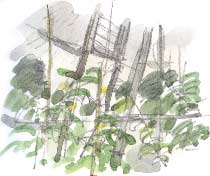Tomato Blight
Richard Bell's Wild West Yorkshire Nature Diary, Monday, 26th July 2010, page
1 of 2
previous | home
page | this month | e-mail
richard | next


 WE'VE
GROWN tomatoes directly in the soil in the greenhouse for several years and
it looks as if they're now being affected by blight. Leaves
are withering on some of the plants and a few of the unripe tomatoes are turning
brown, then mushy.
WE'VE
GROWN tomatoes directly in the soil in the greenhouse for several years and
it looks as if they're now being affected by blight. Leaves
are withering on some of the plants and a few of the unripe tomatoes are turning
brown, then mushy.
I took the precaution of changing the top 6 or 8 inches of soil in spring when
I spruced up the greenhouse ready for this year's crop but I think that next
year I'll go back to our old method of growing the tomatoes in buckets of bought-in
sterile compost. Although blight can linger in the soil in debris from a previous
crop, it's more likely to arrive as an airborne infection. It does look to me
as if the affected leaves are those nearest the vents in the greenhouse.
Blight is a fungus-like organism which can infect tomatoes and the related
potato in humid weather. We've had high humidity recently and I've also been
dowsing the path and soil in the greenhouse twice a day, in order to encourage
lush growth. I also opened the door and the vents every day to keep the greenhouse
well ventilated.
In previous years our plants have been infected with spotty wilt virus
and that's something that can be worse in dry conditions, so it's difficult
to get things just right for this crop!
In contrast, our cucumber is thriving in the humidity. We've
gone for a miniature variety. The half-size cucumbers are just the right size
to last us a couple of days. We should get a few tomatoes too; they're just
starting to ripen.
Garden Snails 
 I
was late going down to close up the greenhouse one night last week. In the half-light
I could see a garden snail and its glistening trail on the
concrete pavier path. I'm sure it has appreciated my efforts to keep up the
humidity. Checking the salad leaves I found a small handful of slugs and snails,
half a dozen of them, which I threw over the hedge into the meadow. They've
probably found their way home by now!
I
was late going down to close up the greenhouse one night last week. In the half-light
I could see a garden snail and its glistening trail on the
concrete pavier path. I'm sure it has appreciated my efforts to keep up the
humidity. Checking the salad leaves I found a small handful of slugs and snails,
half a dozen of them, which I threw over the hedge into the meadow. They've
probably found their way home by now!
The Potato Famine
In the An Unsung Hero, the biography of polar explorer Tom Crean,
Michael Smith mentions the effects of the Irish Famine, brought
about by largely successive bouts of Potato Blight in the 1840s. Rather than
stay working on small family farmsteads which no longer guaranteed even subsistence,
young men like Tom Crean ran away to sea. Crean apparently lied about his age
to join the British Navy. The absentee landlords became increasing unpopular,
Smith explains, and the feeling that Ireland would be better off as a fully
independent, self-governing island gathered momentum.
Potato and
Tomato Blight Royal Horticultural Society
previous | home
page | this month | e-mail
richard | next


 WE'VE
GROWN tomatoes directly in the soil in the greenhouse for several years and
it looks as if they're now being affected by blight. Leaves
are withering on some of the plants and a few of the unripe tomatoes are turning
brown, then mushy.
WE'VE
GROWN tomatoes directly in the soil in the greenhouse for several years and
it looks as if they're now being affected by blight. Leaves
are withering on some of the plants and a few of the unripe tomatoes are turning
brown, then mushy. I
was late going down to close up the greenhouse one night last week. In the half-light
I could see a garden snail and its glistening trail on the
concrete pavier path. I'm sure it has appreciated my efforts to keep up the
humidity. Checking the salad leaves I found a small handful of slugs and snails,
half a dozen of them, which I threw over the hedge into the meadow. They've
probably found their way home by now!
I
was late going down to close up the greenhouse one night last week. In the half-light
I could see a garden snail and its glistening trail on the
concrete pavier path. I'm sure it has appreciated my efforts to keep up the
humidity. Checking the salad leaves I found a small handful of slugs and snails,
half a dozen of them, which I threw over the hedge into the meadow. They've
probably found their way home by now!